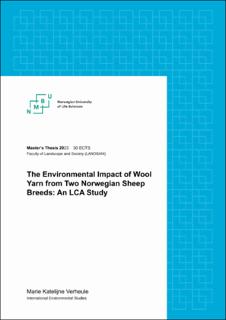| dc.description.abstract | For decades, the clothing industry is one of the most polluting industries. In recent years the clothing industry has been getting more attention due to its unsustainable practices, especially within fast fashion. The transition towards more sustainable business strategies in both social and environmental areas seems to be going slower in the clothing industry than for other large industries (e.g. energy). Recently, there has been bad reflection on the use of wool for clothes because it, supposedly, has a bad impact on the environment. It is here, that the inspiration of this thesis came from. Because of its severe winters, Norway's culture relies heavily on wool clothing and is therefore a perfect setting for this study. The environmental effect of the entire process of making 1820 meters of wool yarn (enough for about one sweater) will be calculated in this thesis using Life Cycle Assessment including wool production and wool spinning. Although the stages of sweater production, use, and disposal would be interesting to investigate, they are outside the scope of this research. A comparison will be made of the production of wool from the two most produced Norwegian sheep breeds; Norwegian White Spæl and Norwegian White Sheep (NWS). To show how much of the impacts from the sheep production is allocated to wool in contrast to meat, economic allocation was used.
The results show that the wool production indeed has a big impact on all impact categories considered. The majority of the effect originate from the production of wool from sheep, which includes enteric fermentation and manure from sheep, production of feed concentrates, grass silage and grazing infield and outfield. The negative effects of the Norwegian White Sheep were greater than those of Spæl in every category except for the risk to biodiversity. The latter results show that sheep production can potentially benefit biodiversity in terms of land occupation from infield and outfield grazing and here NWS could possibly have more positive impact.
The potential total impact of one wool sweater over its whole life cycle was analysed in two separate studies. This shown that wool sweaters, when cared for according to their specific recommendations (e.g. low temperature, air drying, long lifespan, fewer washes, etc.), have a far smaller impact during the usage phase than cotton sweaters, for instance (Laitala et al., 2017; Nolimal, 2018). Wool also fits fairly well into the category of circular products since the recycling of the textiles and clothing is quite easy. | |
